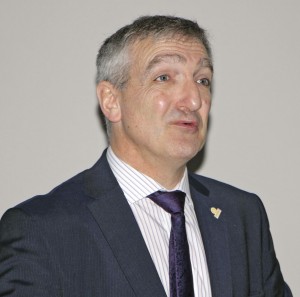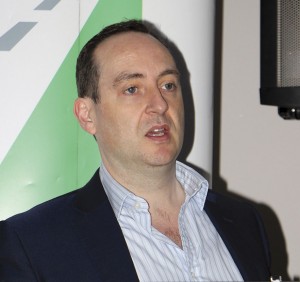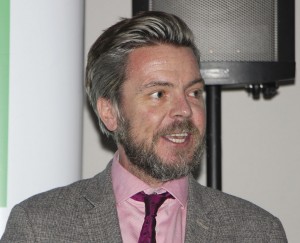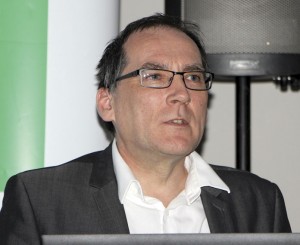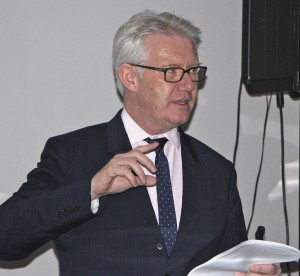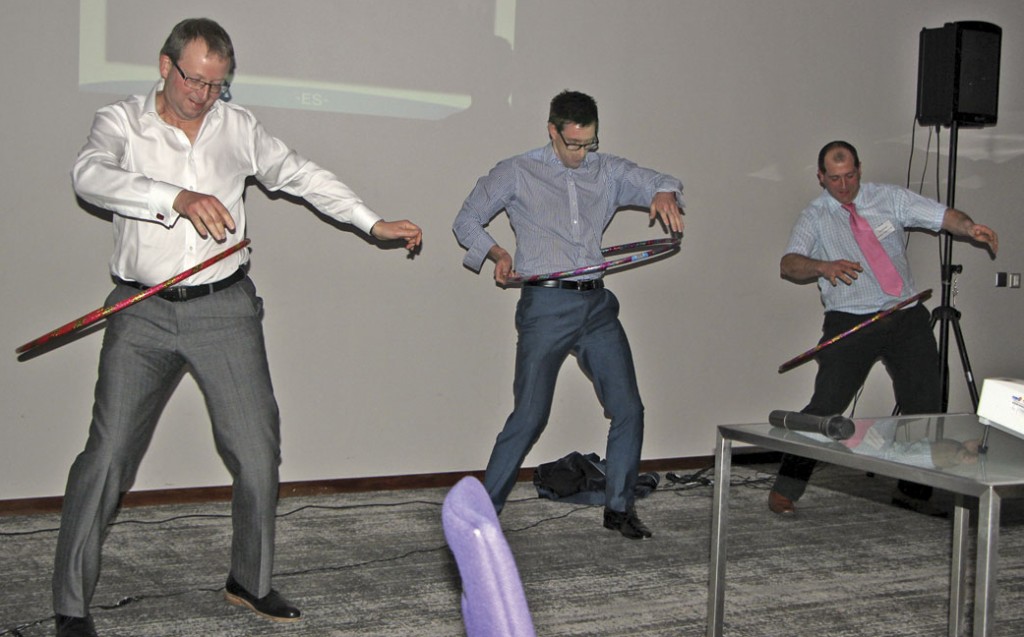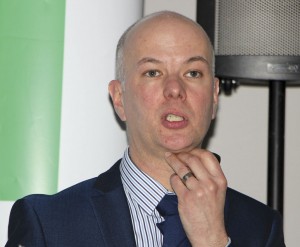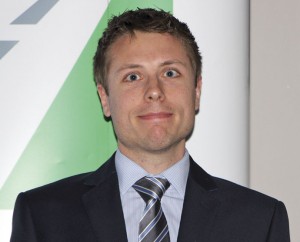CoachMarque Conference 2017
‘Looking after our futures’
Held for the fourth consecutive year at the Radisson Blu Hotel at East Midlands airport, the annual Coachmarque Conference was staged last week. It has a significant social aspect including a dinner and though Stuart Jones missed this, he was present throughout the following day’s business sessions.
According to the organisation’s website, Coachmarque is ‘the only universally recognised kite mark of quality in the UK coach industry. It is concerned with all aspects of the business and not just the coach itself. All CoachMarque companies operate to a strict set of criteria and are regularly assessed by an independent third party to ensure compliance with the highest standards of operation.’ The organisation now has 51 members, the 51st, Bluebird Coaches of Weymouth, being formally presented during the morning’s proceedings.
Two significant changes in personnel over the past year have been the recent election of Chris Owens of Alpine Travel as Chairman as a result of outgoing Chairman Ian Luckett’s forthcoming role as President of CPT UK which begins on 26 January. Another new face is that of Simon Smith, CPT’s Tourism & Coaching Assistant, who has taken on responsibility for the administration of Coachmarque after the retirement of Alf Scrimshaw from the role.
Opening the conference sessions, Chris Owens welcomed delegates, thanked Ian Luckett and introduced Simon Smith as well as welcoming the three latest members: AirLynx, Acklams and Bluebird. For his part, Ian Luckett said he was confident that Coachmarque was on the up but he wanted to see more operators on board which would make it a better industry to be in. There would be no major national marketing campaign unless everyone wanted to pay subs of £30,000 a year so it was up to members to use their Coachmarque accreditation at every opportunity to spread the message. As CPT President, he would be banging on with the message that the coach was part of the solution not the problem.
Tomorrow’s workforce
The first speaker of the day was Martin Christian-Kent of People 1st whose subject was ‘Where are tomorrow’s workforce today?’ You may recall that Martin was also a speaker at the recent CPT Coaching Conference in Warwick and though he covered some of the same ground this was a much wider reaching talk with more emphasis on people management.
The question he posed was, ‘What skills will your business need in five years time?’ The key drivers for this were: environmental, technological, customer service, managerial, legislative and social media. Research showed the industry is very reactive when it comes to its people and it is rare that we take the time to proactively plan, which is perhaps a different approach to that we take with the acquisition of vehicles, he suggested. It was all too easy to be caught out by changing skill needs and suddenly find that you didn’t have the skills your business required.
There were six key components to a successful people strategy and he illustrated these in a wheel. The six were: firstly to analyse people requirements against a business plan; secondly to understand the skills of the existing workforce; then ensure effective training and development; get the most from your staff; deliver high levels of employee engagement and finally recruit the best talent.
The key questions in analysing requirements were: how many staff will I need and do I have enough, do existing staff have the required skills, which of my staff are likely to be here in five years time, are they fully engaged and motivated and am I getting the most out of them? In identifying skill needs, he recommended using performance reviews, training needs analysis surveys and 360-degree reviews. It was important to ensure there would be enough staff for each discipline, to look at how skills could be spread and to consider whether some requirements needed to be in house or could be bought in. To ensure effective training and development, he advocated starting with the end in mind and developing a clear idea of what success looked like. You needed to know not only what you wanted to achieve but also whether training and development was the right intervention, what method of development was the most effective, how to ensure that learning was transferred to the workplace, how to ensure the learner retained the learning or skill and whether the training resulted in a qualification.
To make sure you got the most from your staff and maximised your investment, Martin recommended considering staff work patterns, how the use of technology could change and enhance tasks, the design of jobs, the layout of work areas and the systems and processes in place. Tools that could help were staff working groups, back to the floor experiences and performance reviews. To ensure high levels of employee engagement, the question to ask was, ‘Am I retaining the right staff and are they fully engaged with the business?’ Ask yourself why staff left, whether you are creating the right environment and opportunities to retain staff, whether progression opportunities are visible and whether you are signposting and promoting staff benefits? Useful tools in this are employee engagement surveys, career maps, an annual benefits statement, management development and apprenticeships.
Recruiting the best talent was increasingly important as unemployment was down to 4.9% in 2016 from 8.1% in 2011, while demographic changes meant that by 2022; there would be 700,000 fewer 18-25 year olds and 3.5m more over 50s, something that our industry was better placed that many to cope with. He recommended looking to recruit from industries with similar skill sets.
Financial advice
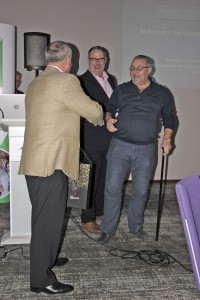
Mick McElhone of Plaxton collects the prize in the Premier Plus champagne draw from Kevin Hull and Chris Clark
Martin was followed by Kevin Hull and Chris Clark of St Neots based independent financial advisers, Premier Plus Ltd. They gave separate presentations, Kevin’s was a leisurely run through business succession planning, aimed primarily at those running their own businesses. The main message was the importance of key man insurance type packages to safeguard the continuing directors and the dependents of an injured or deceased director in the event of an unexpected death or incapacitation. Such packages are also vital to helping ensure the continuation of the business for those it employs. Kevin reminded everyone how important it was to pay for any premiums through the business, as the tax regime meant you were likely to be paying more than double if you paid it out of your own pocket.
Chris delivered a rather more breathless consideration entitled, ‘Pensions Wealth – Keeping it in the Family’. He began by saying that recent changes to pension legislation have finally created the most tax-efficient and flexible opportunities. Planning ahead could result in reductions in Corporation Tax, National Insurance contributions, Income Tax, Inheritance Tax and Capital Gains Tax.
He said new death benefit rules had come in on 6 April 2015 along with the Finance (No.2) Bill in 2016 and under these there were changes to the options available on the death of a pension scheme member. It was important to identify what options were available to you and regularly review death benefit nominations. When a member of a defined contribution scheme died, the funds could be left to: the dependant’s scheme pension in which case it was taxable irrespective of the member’s age at death; a dependant or nominee’s annuity; the dependant or nominee’s Flexi-access Drawdown; as a lump sum to the estate; as a lump sum to a dependant or nominee; or as a charity lump sum. Pension and annuity death benefit options that may be available were: dependant’s flexi-access drawdown, nominee’s flexi-access drawdown, successor’s flexi-access drawdown, joint life annuities for non-dependant beneficiaries, annuity guarantee periods for more than ten years, and transfers of beneficiary drawdown including capped to capped. A pre-existing dependant’s capped drawdown could be converted to flexi-access drawdown providing the scheme allowed it. Not all schemes offered all of these options.
He then concentrated on beneficiary flexi-access drawdown schemes as, he claimed, these offered flexibility, posing a variety of questions that he then provided answers to and illustrating a number of scenarios with case studies. Chris concluded by reminding delegates that the decisions you make today will almost certainly have an impact on tomorrow and urged them not to leave it until their dying breath to do something about it.
Tourism developments
After a coffee break Nick Greenfield of ETOA (The European Tourism Association) spoke on ‘European Tourism Development’, perhaps an easier subject to tackle than the impact of Brexit on tourism which readers may recall he tackled at the London Tourist Coach Forum in December last year, although there was some considerable crossover. Nick is a man with a lot of experience on the ground having worked as a tour guide in 25 different European countries and recently returned from Belarus, the only European nation he had not visited previously. A fascinating and somewhat useless fact he imparted was that etoa means to feel sick in Finnish.
He explained that across Europe there were a number of challenges to tourism including ‘anti-tourism’ in some places and a lack of appreciation by local populations of the benefits that tourism brought to their economies. Too often the local reaction of politicians was a knee-jerk reaction that was ill thought out. Italy was one of the worst places, banishing coaches to inappropriate places and, in the case of Rome, threatening to introduce a €1,000 a day charge for a coach to visit but there were signs that some cities, such as Florence, were starting to engage with ETOA.
Nick thought that more and more people did not want to be tourists, they wanted to live like locals; they wanted to be hands on and were looking for an experience. The two things keeping many tour companies going in the face of the ability to book everything yourself on the internet were trust and the ability to provide that hands on experience. He recommended finding ways that made your product appeal to specific target markets. Apparently the Spanish have a thing about Alexander Fleming and there is a Bollywood connection with Switzerland that has kept Indians coming back for many years. Mobile phone developments were, he thought, perhaps more significant to tourism than the internet. There was information overload but people were time poor so for tourism providers it was about added value; they needed to broadcast that and make people aware. As an industry we weren’t doing enough of it.
Electric coaches?
Speaking on ‘The Coach of the Future – Electric’ BYD UK’s Technical Manager, Michael Kerslake, began by saying that BYD didn’t currently have an electric coach product for the UK but it had produced prototype vehicles for Paris and the USA. The company had been founded as recently as 1995 as a lithium ion battery developer and manufacturer, built its first vehicle in 2003, and was now the world’s largest manufacturer of rechargeable batteries and new energy vehicles. It had its European headquarters in Rotterdam.
The LiFePo4 batteries BYD used were very stable. Battery performance was continually improving with energy density growing 10% annually and the price differential with diesel was narrowing. BYD not only made the vehicles, the battery packs and the cells in them, the power electronics and the traction motors; it also manufactured and supplied the charging infrastructure which was proven with large fleets in operation.
Looking at factors in favour of electric coaches, Michael listed: zero emissions, lower energy costs than diesel, a lower CO2 footprint, quieter operation and a marketing opportunity with clients such as schools and environmentally conscious customers. Currently against electric coaches were the cost, a lower range than diesel and a lack of public recharging infrastructure. There would be a chunk of cost upgrading the infrastructure and there was no standard way of financing that at present. You had to work out the right balance of cost, payload and range for the UK market.
Addressing the issue of battery life, he said, it was explained that the calculations given were based on a battery that was 20% depleted. It would take around ten years for it to reach that stage based on 10,000 cycles and at 20% depleted a Lithium Ion battery was still better than a new lead/acid unit. The anticipation was that depleted batteries would have a second life and therefore a residual value for storing energy in a variety of applications.
Asked why hybrid was not being put forward for coaches, Michael pointed out that the cost of batteries for hybrids was not coming down very quickly because the units required were more specialist high energy ones. He did not think hydrogen was ever going to be viable as a fuel because even if it fell in price, it would not keep up with the reducing price of electric.
On maintenance, it would need less than a diesel and most parts were conventional. The batteries did not require cooling but it was expedient to discharge the batteries from 100% to 0% every six months.
Motivation in the workplace
After lunch, the bulk of the afternoon session was given over to a lengthy presentation on ‘Motivation in the workplace’ by Andrew McMillan of Engaging Service, a consultancy specialising in the employee and customer experience. Andrew’s career included 28 years with the John Lewis Partnership, rising from the shop floor to run the furniture floor at the Oxford St store before working for the Chairman to run the intelligence team, an internal consultancy. In this role he wrote a report saying that actually their customer service wasn’t too good. After John Lewis he spent some time with a consultancy before he set up his own operation in 2011. He has since worked with a varied client base including Arriva on the Sapphire brand, Abellio and Virgin on rail and also several airlines as well as in non transport fields such as adult social care.
After talking a little about John Lewis and illustrating how happy staff consistently treating the customer well could transfer a halo effect to the brand; he asked in reference to his theme, ‘Motivation to do what and for what purpose?’ He argued that it was important for teams to really look after each other to create an amazing atmosphere at work and create a remarkable atmosphere for your customers so that your customers become even more loyal, recommend you to lots more people and you grow your business or establish it as more sustainable.
Using a three ring target graphic with ‘What’ in the outer ring, ‘How’ in the intermediate ring and ‘Why’ in the bulls-eye, he suggested that all of us know what we are doing, some of us know how we are doing it but many do not know why we are doing it. It was important companies and their people knew why they were doing what they were doing. He argued that one of the reasons that a relatively small airline like Virgin consistently punched above its weight was that the company’s key ethos, the centre of the target, was: ‘We’re on a mission to make every second you spend with us awesome.’ All of the staff knew it, they were recruited for their ability to live up to it, and the thought motivated all of their actions and Virgin projected this approach through promotions such as the ‘Be bound for glory’ campaign, the video for which Andrew showed to delegates.
Defining the customer experience, he said it was made up of: the product or service which had to be right, though it did not have to be different; the process, or how easy you are to deal with; the channel or how easy you are to access; and engagement or how it felt. All of these were inter-dependent. Expanding on the channel aspect he said, ‘Only go digital to the extent that your customers expect, don’t neglect face to face and telephone.’
A random experience was inconsistent and unintentional, and moving up the scale a predictable experience was consistent and intentional, a branded customer experience added differentiation and value to consistency and intentionality with the ultimate goal of greater profit. Customer engagement, if you could reach it, was when ‘the experience delivered by the staff is so consistently good that the staff become the organisation or brand in the eyes of its customers.’ Benefits of achieving engagement were an improved staff experience and consequent reduced costs through lower turnover and improved productivity, an improved customer experience with increased revenue through enhanced loyalty and advocacy as well as reduced complaints and better sales conversion. The six steps to engagement were define, measure, communicate, lead, reward/recognise/appraise and finally recruitment and induction.
He stressed the importance of hiring and developing leaders and managers who could engage people, pointing out that after studying 2.5m managers in 195 countries it found that only one in ten had the disposition to be great managers and only another two in ten could effectively manage. ‘Often people and their managers were working so hard to make sure things were done right that they hardly have time to decide if they are doing the right things’, he said.
‘Leadership’, he said, ‘is a performance. You have to be conscious of your performance, because everybody else is.’ You have to set out what you want and in the end people will start to copy and in the end they will start to reinterpret.
‘Hire for attitude – fire for attitude’, he said, and he was unequivocal about people who didn’t fit in saying, ‘If you get someone in your business who isn’t right and is miserable, get rid of them – fast.’ If you looked at attitude and energy there were four types of employees – there were the walking dead who had neither and the spectators who appeared to have the right attitude but contributed nothing. You didn’t want either of these groups. The ones you wanted were the players who had both attributes and the cynics who put the work in but questioned what they were doing.
For engagement to work people needed to enjoy work and have fun. Lack of trust was the biggest barrier to overcome in building a collaborative relationship with the team. Having fun at work was a balance and four pointers he gave to achieving it were: Not asking how we could have fun, rather what prevents us having fun; knowing when to have fun and weighing the risk; accepting the risk and doing it anyway; and finally, asking for forgiveness rather than permission.
Illustrating the fun at work theme and demonstrating that there it was not difficult to create fun in a working environment, he invited four male members of the audience to volunteer. When they had done so he presented them with hats and showed a clip of the culmination of the film ‘The Full Monty.’ There were some worried faces before he took back the hats and handed out hoola-hoops for a competition judged by the audience. A subsequent game involving beach balls raised energy levels in virtually the whole audience.
Andrew concluded that fun in the workplace must be all-inclusive (which meant available to all rather than compulsory), it did not have to mean unprofessionalism and could make you more professional, if you got it right you would be identified by employees and customers as a fun place to spend time and your business could potentially be much better as a result.
Distinctive developments
The final session of the day was an optional one for those members who use the products of Distinctive Systems. Scheduled for 45 minutes it ran considerably over that, partly because of the number of innovations there were to explain and partly because of the valuable feedback generated. Delivered by Paul McJannett with Andrew Fraser in attendance, they began by saying that the business now had 1,500 clients using the current generation systems, and 16 employees at its UK offices as well as seven in the USA and two in Australia.
Enhancements to Coach Manager coming soon included an on-line client portal that would enable operators to compete more equally, HTML quotation and confirmation letters and private hire and quotation tasks.
Coach Manager was also being integrated with LICENCECHECK so that it would be quick and easy to directly import licence details with no additional hardware or software required. Credit packs available would enable a single check to be undertaken for £3.70. Operations staff would be automatically warned about licence validity dates, licence status, endorsement points and category entitlement including restrictions. Coming in Quarter 2 would be the availability of Tacho Card and CPC data.
New features and capabilities for the Tour Booking System included to-do lists, tour departure tasks and on-line guest bookings, to which discount codes would soon be added.
For the Vehicle Maintenance System there was a new Android App for driver’s walk around checks with an iOS version to follow, a stock control bar coding Android App, third party GPS integrations and mobile friendly electronic job cards. Paul spent some time explaining all the functions of the walk around App that is free to existing users of Coach Manager, Tour booking System and VMS although a monthly subscription or software maintenance agreement is required.
This is not a comprehensive list of the developments Distinctive Systems is currently undertaking. Anyone operating the systems and wanting to know more is advised to contact the company.
Asked afterwards whether Distinctive aimed to migrate its systems to the Cloud, Paul confirmed this was the case and many of the developments shown were part of this. He said the company tried to tell operators about things it was doing rather than things it was going to do but he hoped that they would be able to show it at this year’s show. He also confirmed that all of the new features would be iOS compliant by the second quarter of 2017.
Last word
The speakers were of a good standard and those attending will have found the conference worthwhile with food for thought provided to assist them in the future. Useful though the business sessions are, at least as important is the opportunity to meet fellow operators and talk about mutual challenges, or just make a contact that might be valuable at a future time of need. If you would like to know more about becoming a member, contact Simon Smith at CPT.
